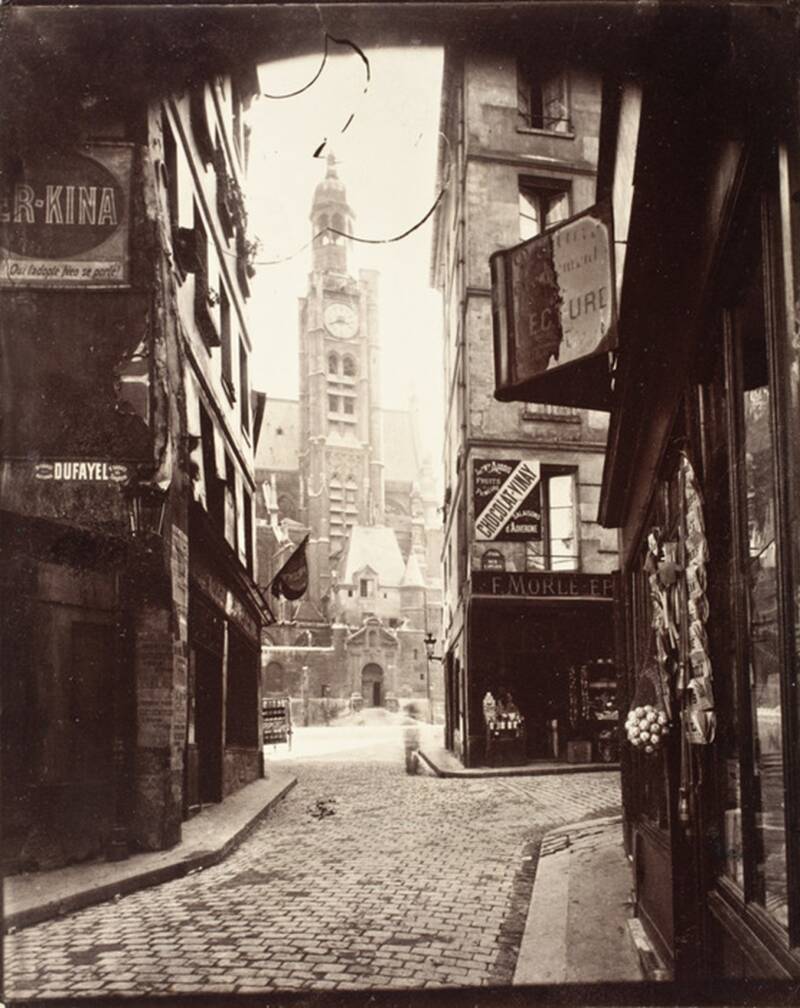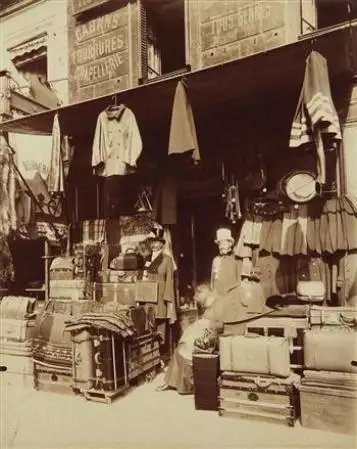Berenice Abbott, Day View from the Empire State Building, 1929, 6 x 9 cm negative

1928: Berenice Abbott: "How can anyone but a photographer hope today to fix for posterity the image of the modern city?"
BJ Kospoth, "An Imager of Paris," Chicago Tribune (Paris Edition), Sunday, November 28, 1928, 5 AA (Abbott Archives, Paris Scrapbook, page 55)
1930: Berenice Abbott: "Neither writing nor drawing can convey the horror of an event as photography can convey it. It is only too well known that the printed word loses its effectiveness through staleness. Drawings, too, are often discounted because people know the matter has been interpreted by the artists and they unconsciously allow for exaggeration. A photograph is absolutely veracious and gives an effect as fresh as life."
Sarah Morris, "Fits Art to Age: Miss Abbott Identifies Photography with America," Brooklyn Eagle, Sunday, December 14, 1930.
Berenice Abbott, Retail Establishments, Hester Street, Lower East Side, New York, 1929, 6 x 9 cm negative, a variant of this image was published in Transition, June 1929.

1930: Berenice Abbott: "I want to help build up something here in New York—to have people realize that they have something here that is simply tremendous."
Lillian Sabine, "Berenice Abbott, of New York City" Abels' Photographic Weekly, December 15, 1930, 263.
1931: Berenice Abbott: "There is nothing so romantic as reality, no fiction so exciting as the ordinary things about us if only one has the eyes to behold them."
Sarah Carlton, "Berenice Abbott Photographer," The American Girl, August 1931, 12-13.
1931: Berenice Abbott: "A photograph is a document which may stand as testimony of a period whose folk, architecture, fashions, and modes of transportation have been supplanted. It may also be an interpretation."
Sarah Carlton, "Berenice Abbott Photographer," The American Girl, August 1931, 12-13.
Berenice Abbott, Cigar Store Indian, New York, 1929, 6 x 9 cm negative.

1931: Berenice Abbott: "I am an American who, after eight years residence in Europe, has come back to view America with new eyes. I have just realized America—its extraordinary size, its youth, its unlimited material for the photographic art, its state of flux particularly as applying to the city of New York.
"America, to be interpreted honestly, must be approached with love void of sentimentality, and not solely with criticism and irony."
Abbott's application to the John Simon Guggenheim Foundation, October 30, 1931, Abbott Archives, "S" folder, pages 1 and 1a.
Berenice Abbott, Trinity Church from Wall Street, New York, 1929, 6 x 9 cm negative

1931: Berenice Abbott: "When the proper medium of photography will have been understood, it will be recognized as having a most descriptive literary value and to be most suitably adapted to the recording of historical facts. The monumental work of Eugene Atget with his vision and realization in the photographing of Paris, which collection of prints and plates I own, is valid proof of what such a work can signify."
Abbott's Proposal to Hardinge Scholle at the Museum of the City of New York, November 1931, Abbott Archives, "Museum of the City of New York" folder.
Eugène Atget (French, 1857–1927), Rue De La Montagne Au Geneve, 1910, salt print.
Berenice Abbott, Under the Elevated at Battery Place with Traffic, New York, 1929, 6 X 9 cm negative

Berenice Abbott, Coenties Slip, New York, 1929, 6 x 9 cm negative.

Berenice Abbott, Union Square Cigar Store Indian, New York, 1930, 8 x 10 inch negative

1931: Berenice Abbott: "The photographs that Mathew Brady, with the most primitive technique, made of the Civil War period are also of authentic historical value. Recognizing this manner of recording, there is no better or more vivid form with which to save for the future visions of this city’s extraordinary growth and rapid changes…."
Abbott's Proposal to Hardinge Scholle at the Museum of the City of New York, November, 1931, Abbott Archives, "Museum of the City of New York" folder.
Mathew Brady (now attributed to James F. Gibson, b. 1828/9), Yorktown Landing, 1862, described in the 1930s as “The Stockade of City Point, Virginia, 1864,” albumen silver print from a glass negative. Abbott ordered a print of this image from the War Department in September 1930 and contributed it to a German publication in 1931 with an essay discussing the "Alte Sachlichkeit."
Berenice Abbott, George Washington Bridge Under Construction, New York, 1930, 8 x 10 inch negative
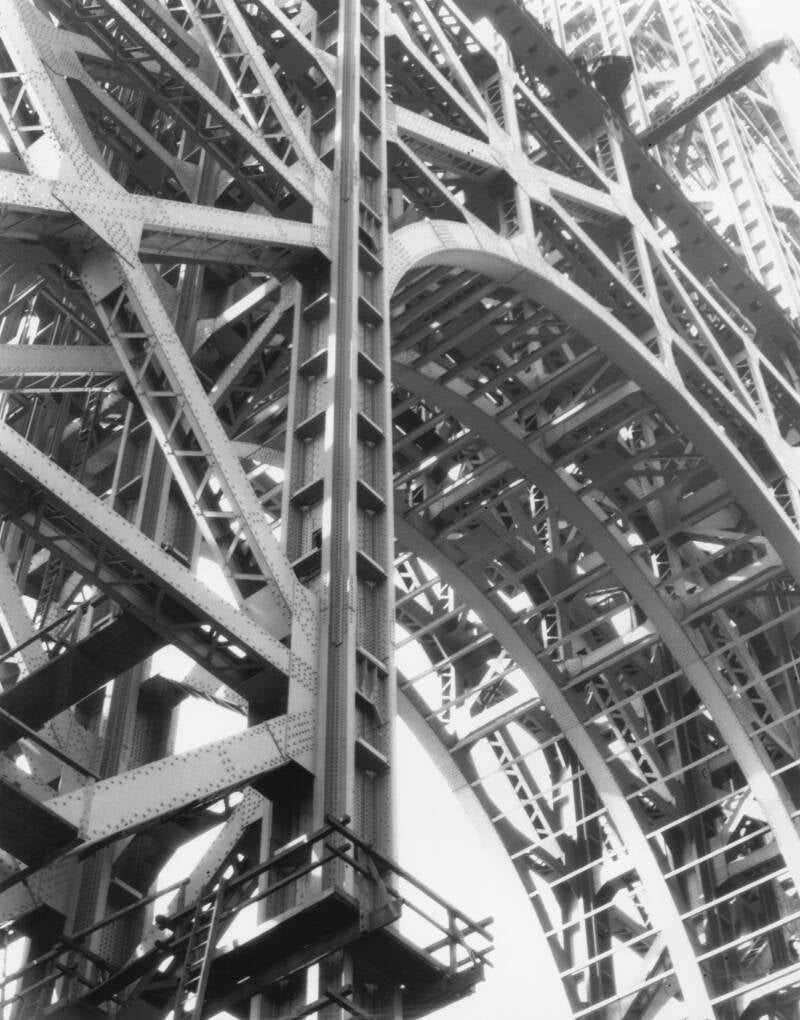
Berenice Abbott, Saints for Sale, New York, formerly known as “Statuary Shop, 382 Water Street, New York,” 1931, 8 x 10 inch negative.
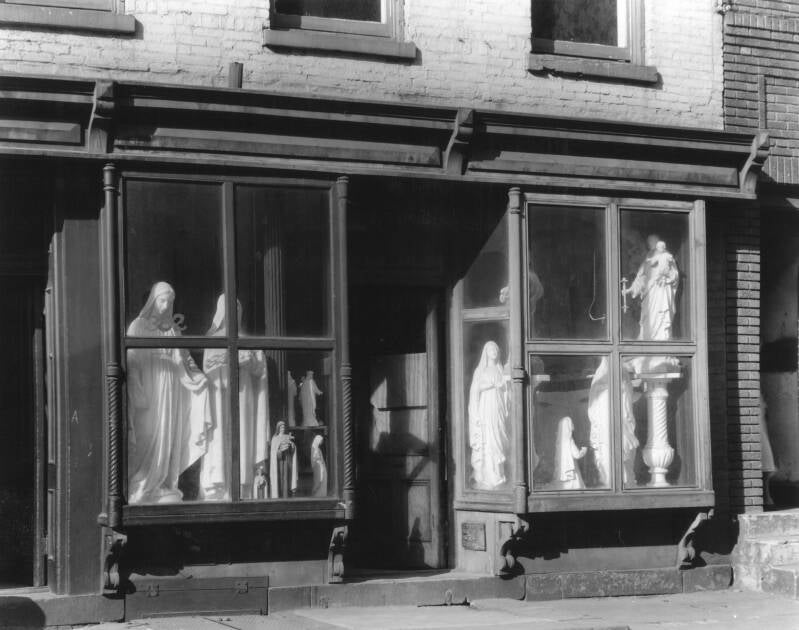
1934: Berenice Abbott: "I have and have had a fantastic passion for New York, photographically speaking."
Letter from Berenice Abbott to Elizabeth McCauland, October 29, 1934, Archives of American Art microfilm reel 382, frames 285-288.
1935: Berenice Abbott: "It is important that relics of the age of General Grant or Queen Victoria, where these have survived the onward march of the steam shovel, should be photographed today, not tomorrow; for tomorrow may see many of these exciting mementos of the 18th- and 19th-century New York swept away to make room for new colossi.
"If there were photographs of Imperial Rome in the days before the decline of the Roman Empire, these would be priceless historical documents. So, the future unquestionably will consider the photographs of the American Civil-War photographer Brady and the French master Atget. All work that can salvage from oblivion some such memorials of the metropolis will have a similar value."
Abbott's Proposal to the Emergency Relief Bureau, Abbott Archives, "WPA" folder.
Berenice Abbott, Front Street at Peck Slip, New York, 1932, 8 x 10 inch negative
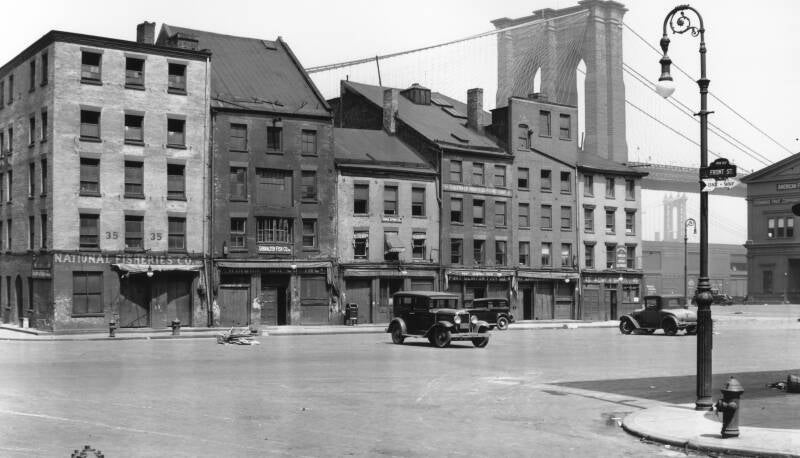
Berenice Abbott, New York at Night, a.k.a. Night View New York, 1932, 4 x 5 inch negative

Berenice Abbott, Floating Oyster Houses, South Street and Pike Slip, New York, c. 1932, 8 x 10 inch negative

Berenice Abbott, Trinity Church and Wall Street Towers, New York, 1934, 8 x 10 inch negative

Berenice Abbott, Trinity Church and the Equitable Building, New York, 1935, 4 x 5 inch negative

Berenice Abbott, Broadway & Rector from Above, New York, 1935, 4 x 5 inch negative

Berenice Abbott, Canyon: Stone & William Streets, New York, 1935, 8 x 10 inch negative

1935: Berenice Abbott: "The city is, we think, the material structures where human beings live and work and amuse themselves; the facilities by which living is made possible, the rapid transit and communication systems, the elaborate organization of food supplies; the places where men and women carry on their business, their home-life, their relaxation, their functions as citizens, the people themselves. Twenty-four hours a day, life pulses through the metropolis complex and hectic. Everything that happens should go into the photographic history of the city."
Berenice Abbott, "Outline for Photographing New York City, undated (October 1935), Abbott Archives "WPA" folder.
1936: Berenice Abbott: "My photographs… will have elements of formal organization and style; they will use the devices of abstract art if these devices best fit the given subject; they will aim at realism, but not at the cost of sacrificing all esthetic factors.
"They will tell facts about street signs, the shapes and forms of trolley cars, buses, taxis, private motor cars, buildings, store front window displays, news-stands, elevated stations, details of wrought iron grilles, architectural décor, styles of lettering on signs of all sorts, etc., etc., etc. But these facts will be set forth as organic parts of the whole picture, as living and functioning details of the entire complex social scene.
"The photographs will not be out and out 'record' photographs. If a telephone of 1936 is photographed, it will be in the context of 1936, not from cut and dried shots of an object, say a kitchen stove looking like something out of an ad, but a kitchen stove in real life. It is important to make this distinction of the overtones of difference between 'documentary' and 'record' photographs."
Berenice Abbott, "Confidential" letter to MJ Kaufmann, Abbott Archives, "WPA" folder, 1.
Berenice Abbott, Saint Paul’s Chapel of Trinity Parish, New York, c. 1935, 8 x 10 inch negative

Berenice Abbott, Fulton Fish Market, New York, 1935, 8 x 10 inch negative

1940: Berenice Abbott: "Suppose we took a thousand negatives and made a gigantic montage: a myriad-faceted picture containing the elegances, the squalor, the curiosities, the monuments, the sad faces, the triumphant faces, the power, the irony, the strength, the decay, the past, the present, the future of a city—that would be my favorite picture."
Berenice Abbott, "My Favorite Photograph," Popular Photography 6 (February 1940), 19.
1940: Berenice Abbott: “'Civic Documentary History.' What does this phrase mean?... Roughly, for purposes of immediate definition, we may say that the function of photography for Civic Documentary History is to record, to interpret, and to comment.
…
"The word 'civic' suggests the human being in relation to his social environment. It implies that he, as a citizen, has a responsibility for this environment, its status quo, and the possibilities of its improvement in the future.
…
"'Documentary' photography is realistic, objective—the more realistic, the better…. It seeks to reach the roots, to get under the very skin of reality.
…
"The history the camera can write is the visual record of the present. The camera cannot reconstruct the past or imagine the future. But the camera CAN see and record the instant NOW."
Berenice Abbott, "Civic Documentary History," Proceedings of the Conference on Photography: Profession, Adjunct, Recreation (New London, Connecticut: The Institute of Women's Professional Relations, February 9, 1940, 71-72.
Berenice Abbott, Coenties Slip, New York, c. 1935, 8 x 10 inch negative

Berenice Abbott, Under the El at the Battery, New York, 1936, 8 x 10 inch negative

Berenice Abbott, Barclay Street Station, New York, 1936, 8 x 10 inch negative

Berenice Abbott, Passport Photos, Downtown, New York, 1936, 8 x 10 inch negative

Berenice Abbott, Manhattan Bridge with Pier 21, Pennsylvania Railroad, New York, 1937, 8 x 10 inch negative

Berenice Abbott, Queensboro Bridge, New York, 1937, 8 x 10 inch negative

Berenice Abbott, Gambetta Snuff Shop, 113 Division Street, New York, 1938 8 x 10 inch negative

1940: Berenice Abbott: "Some people have tended to confuse Atget’s work and mine, not understanding the different forces at play in the two periods.
"Essentially, Atget belongs to the 19th century tradition. He is a true poet, a romantic. The world he recorded was a world externally and visually rooted in the past. There is an aura of nostalgia often in his photograph, not in his approach, but in their very content.
"Atget’s work ended in 1927. My own documentary work did not start till 1929. From the technical point of view, we worked with different resources, though I too have believed that the big camera is the best machine for this kind of photography.
"Our cities are different. New York could only be the child of the New World…. The psychic clime is tropical in comparison with the crepuscule which Paris often can be.
"Externally and visually New York is the face of the modern city, bred of industrial centralization. Paris remains the symbol of pre-industrial civilization of a hand craft economy…."
Letter from Berenice Abbott to Ansel Adams, June 14, 1940, Abbott Archives, "Atget Exhibition" folder.
Eugene Atget, Boutique d'articles pour hommes, 16 rue du Petit-Thouars, 1910, alumen print.
Berenice Abbott, Hardware Store, New York, 1938, 8 x 10 inch negative

1941: Berenice Abbott: "I may feel that the skyscrapers are beautiful and majestic. Or I may feel that they are ugly, inhuman, illogical, ridiculous, pathological growths which have no place in the planned city. Whatever I think and feel about the skyscrapers, I say through understanding and application of composition. Vertical lines may seem to topple toward each other, or to fall apart, ready to collapse; they do not create a balanced whole. On the other hand, the photograph may represent the skyscraper in such a way that verticals sway in a majestic and graceful rhythm expressing unity and order. Even more complex is the problem if the photographer sees the skyscrapers as both beautiful and ugly and seeks to create such a duality in the photograph by posing tendencies against each other in dynamic composition."
Berenice Abbott, A Guide to Better Photography (New York: Crown Publishers, 1941), 22.
Berenice Abbott, Tempo of the City, New York, 1938, 4 x 5 inch negative

Berenice Abbott, Wall Street Canyon from above, looking toward Trinity Church, New York, c. 1961, 4 x 5 inch negative

